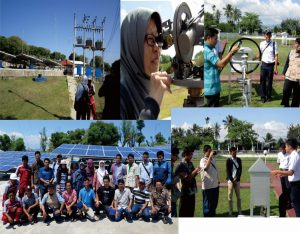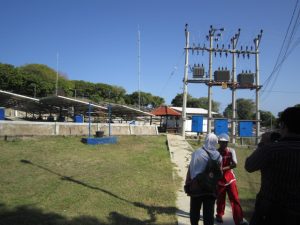Homepage : http://www.es.itb.ac.id/

The Master and Doctoral Degree Program of Earth Sciences was established in 1995 and 2003. Its goal is to produce graduates with a thorough academic knowledge and professional skills, and to develop and apply oceanography, atmospheric science, and seismology for geohazard reduction. The programs are under the Postgraduate Program of Institute Technology Bandung and have been running by the Faculty of Earth Science and Technology with two Specific Sub-Programs
The Master and Doctor’s Program of Earth Sciences has three specific sub-programs as follows:
1. Oceanography
Students learn the physical and dynamic properties of marine waters that are important for the marine industry/technology, environment, and exploration of renewable marine resources.
Research Interests: Wave modeling and analysis; Coastal waters dynamics (hydrodynamics and transport phenomena); Modeling the marine environment (local, regional and global); Ocean-air interactions and ENSO; Management of coastal waters environment; Tide and long wave analysis and modeling; Sea surface topographic analysis and modeling; Marine ecosystems and global changes; Oceanographic fisheries
Recent and Present Research: coastal morphodinamics, 3D thermal dispersion models around power plants, oil spill modeling, marine modeling hydrodynamics, wave modeling and analysis, seawater quality modeling, ecological planning for marine aquaculture, tidal data analysis and modeling , sea surface temperature and elevation models in Indonesia and adjacent waters associated with the ENSO phenomenon, tsunami modeling associated with coastal protection issues, predict movement of warm pools, salinity fronts and convergence zones associated with fishing ground using combined hydrodynamical-ecological models, and sediment transport phenomenon.
2. Seismology
Students learn the physics of earth. There is a particular emphasis on studying earthquake-related issues due to high seismic activity in Indonesia and marine geophysics that is to develop the prospect of non-renewable marine resources.
Research interests: seismic modeling and anisotropy, gravity and geomagnetic modeling, geoelectric and electromagnetic modeling, geodynamics and seismotectonics, environmental geophysics: Earthquake and tsunami hazard assessment; Local, regional and global seismic tomography; Mechanism of earthquake source and prediction; Theoretical geophysics
Recent and Present Research: seismic modeling for hydrocarbon exploration; Gravity and geomagnetic modeling for mineral exploration; Geodynamics and seismotectonics from the territory of Indonesia; Earthquake and tsunami hazard assessment for Indonesia; Non-linear seismic tomography from upwelling (feathers); Seismic anisotropy under Lake Toba; Assessment of earthquake predictability; Ray 3D tracing on a round earth; Statistical analysis of Indonesia earthquake data


3. Atmospheric Science
Students learn to assess the physical and dynamic atmosphere in order to solve climate and weather problems. There is a particular emphasis on studying issues relating to the Indonesian maritime continent that form an active convective region.
Research interests: tropical monsoon and intraseasonal variability; El-Nino Southern Oscillation (ENSO) and inter-annual variations; Long-term variations and global climate change; Regional climate response to global change; Mesoscale meteorology; Hydrometeorology; Coastal and maritime meteorology; Hydrometeorology; Environmental meteorology; Meteorology of the Indonesian maritime continent; Meteorological engineering
Recent and Present Research: ENSO: prediction model and analysis of its impact on regional climate; Drought mechanisms during Indonesia’s maritime continent; Micro-climate change in newly developed transmigration areas; Induced field flow modeling; Sea / land circulation wind; Air pollution and modeling pollution; Global warming and climate change.
Qualification:
1. Graduates of science or engineering with sufficient mathematical and physical background.
2. Pass the selection
